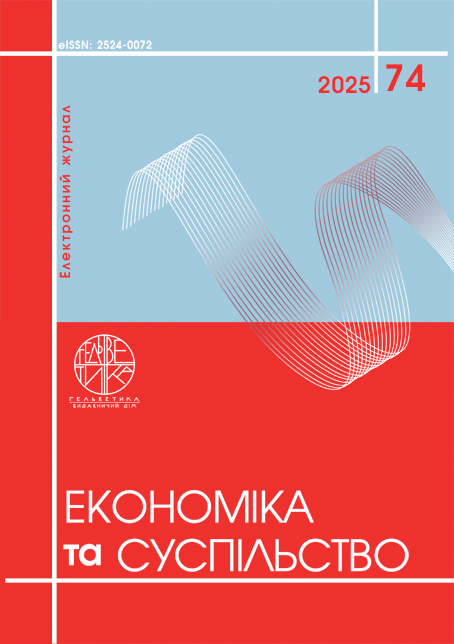INNOVATIVE ANALYSIS METHODS FOR ACCURATE TAX FORECASTING AND OPTIMAL PLANNING OF BUSINESS ACTIVITIES
Abstract
In the contemporary economic landscape, shaped by rapid digitalization and significant challenges, particularly the ongoing martial law in Ukraine, accurate tax forecasting and effective tax planning are crucial for national financial stability and business viability. The article investigates innovative analytical methods, specifically machine learning (ML) algorithms and Big Data analytics, to enhance the precision of tax forecasting and optimize business entities' activity planning. We argue for a systemic approach that integrates the analysis of economic processes, taxpayer behavioral aspects, and the dynamic legal environment amid Ukraine's transformations and wartime conditions. The study analyzes the application of ML models for predicting tax revenues, managing tax risks, and facilitating optimal tax planning strategies. We also explore the prospects for adapting and integrating these advanced methodologies within the unique Ukrainian context, considering the specific challenges of martial law and post-crisis economic recovery. A key focus is on the intricate interplay between economic dynamics, taxpayer psychology, and the legal framework, highlighting how state regulatory influence during wartime can induce psychological strain on businesses. This underscores the urgent need for sophisticated analytical tools to navigate such complexities. The research further identifies the critical roles of judicial precedent and the organizational-legal form of enterprises as pivotal legal aspects impacting tax planning. These elements, often under-examined in conventional analyses, require refinement and integration through innovative analytical approaches to ensure more precise forecasting and effective planning. The paper advocates for a shift from traditional, often intuitive, calculations to data-driven models, powered by AI and ML. This transformation is vital for mitigating tax risks, ensuring transparency in taxpayer-state relations, and ultimately contributing to more efficient tax administration. Our findings suggest that adopting ML in tax policy forecasting and planning is a promising direction, enhancing efficiency and necessitating investments in IT infrastructure, quality data, and skilled personnel capable of integrating ML into practical tax management.
References
Греца, Я. В. (2020). Зміст, правові засоби та межі податкового планування зарубіжний досвід та українська практика : монографія. Ужгород : ТОВ «РІК-У». 420 с.
Tagliaferri, G., Scacciatelli, D., & Alaimo Di Loro, P. (2022). VAT tax gap prediction: a 2-steps Gradient Boosting approach. Statistical Methods & Applications. URL: https://arxiv.org/abs/1912.03781 (дата звернення: 20.05.2025).
Wong, C. H., & La, N. (2024). Applying machine learning in tax revenue forecasting. Victoria’s Economic Bulletin, 8(2). URL: https://dtf.vic.gov.au/victorian-economic-bulletin/victorian-economic-bulletin-spring-2023-edition-82 (дата звернення: 20.05.2025).
Li, X. (2023). Financial Fraud: Identifying Corporate Tax Report Fraud Under the XGBoost Algorithm. EAI Endorsed Transactions on Scalable Information Systems. URL: https://www.researchgate.net/publication/370706475_Financial_Fraud_Identifying_Corporate_Tax_Report_Fraud_Under_the_Xgboost_Algorithm (дата звернення: 20.05.2025).
Murorunkwere, B. F., Ngarukiye, H., & Ntirugiribambe, A. (2022). Fraud Detection Using Neural Networks: A Case Study of Income Tax. Future Internet, 14(6), 168. URL: https://www.mdpi.com/1999-5903/14/6/168 (дата звернення: 21.05.2025).
Pantelieieva, N. (2022). Digital transformation of tax administration. Traektoriia Nauki, 8(1). URL: https://pathofscience.org/index.php/ps/article/view/805(дата звернення: 21.05.2025).
Тлучкевич, Н., Оксана, Н., & Писаренко, Т. (2023). Управлінський аспект податкового планування в умовах невизначеності. Економічний форум, 1(2), 66–71. DOI: https://doi.org/10.36910/6775-2308-8559-2023-2-10
Anisimov, V. (2024). Automation of Tax Processes and Their Impact on Decentralized Public Finance Management in Ukraine. Visnyk Khmelnytskoho Natsionalnoho Universytetu, (5). URL: https://heraldes.khmnu.edu.ua/herald/index.php/en/journal/article/view/852 (дата звернення: 22.05.2025).
Xu, C., & Kong, Y. (2024). Random forest model in tax risk identification of real estate enterprise income tax. PLOS ONE, 19(2), e0298017. URL: https://journals.plos.org/plosone/article?id=10.1371/journal.pone.0298017 (дата звернення: 22.05.2025).
A1 Consulting. (2024, February 22). Виявляє ухилення, несплату та ризики: як ШІ впливає на сферу податків. URL: https://mc.today/uk/blogs/yak-chatgpt-ta-vzagali-shtuchnyj-intelekt-vplyne-na-podatkovu-sferu-v-tsilomu-ta-podatkovyj-konsaltyng-zokrema/ (дата звернення: 22.05.2025).
Греца, В. Я. (2023). Модифікація податкової системи в умовах воєнного стану. Науковий вісник Ужгородського Національного Університету. Серія ПРАВО, (78, частина 2), 24–31. DOI: https://doi.org/10.24144/2307-3322.2023.78.2.3
Рішень в аналізі, аудиті та оподаткуванні. (2023). Економіка і суспільство, (51). DOI: https://doi.org/10.32782/2524-0072/2023-51-54
Писаренко, Т. Ю. (2023). Психологічні аспекти поведінки платників податків в умовах воєнного стану. Збірник наукових праць «Економіка та суспільство», (51). DOI: https://doi.org/10.32782/2524-0072/2023-51-54
Gretsa, Ya. V. (2020). Zmist, pravovi zasoby ta mezhi podatkovoho planuvannia zarubizhnyi dosvid ta ukrainska praktyka [Content, legal means and limits of tax planning: foreign experience and Ukrainian practice]: monohrafiia. Uzhhorod: TOV «RIK-U». 420 p. (in Ukrainian)
Tagliaferri, G., Scacciatelli, D., & Alaimo Di Loro, P. (2022). VAT tax gap prediction: a 2-steps Gradient Boosting approach. Statistical Methods & Applications. Retrieved from https://arxiv.org/abs/1912.03781 (Accessed: May 20, 2025).
Wong, C. H., & La, N. (2024). Applying machine learning in tax revenue forecasting. Victoria’s Economic Bulletin, 8(2). Retrieved from https://dtf.vic.gov.au/victorian-economic-bulletin/victorian-economic-bulletin-spring-2023-edition-82 (Accessed: May 20, 2025).
Li, X. (2023). Financial Fraud: Identifying Corporate Tax Report Fraud Under the XGBoost Algorithm. EAI Endorsed Transactions on Scalable Information Systems. Retrieved from https://www.researchgate.net/publication/370706475_Financial_Fraud_Identifying_Corporate_Tax_Report_Fraud_Under_the_Xgboost_Algorithm (Accessed: May 20, 2025).
Murorunkwere, B. F., Ngarukiye, H., & Ntirugiribambe, A. (2022). Fraud Detection Using Neural Networks: A Case Study of Income Tax. Future Internet, 14(6), 168. Retrieved from https://www.mdpi.com/1999-5903/14/6/168 (Accessed: May 21, 2025).
Pantelieieva, N. (2022). Digital transformation of tax administration. Traektoriia Nauki, 8(1). Retrieved from https://pathofscience.org/index.php/ps/article/view/805 (Accessed: May 21, 2025).
Truchkevych, N., Oksana, N., & Pysarenko, T. (2023). Upravlinskyi aspekt podatkovoho planuvannia v umovakh nevyznachenosti [Managerial aspect of tax planning in conditions of uncertainty]. Ekonomichnyi forum, 1(2), 66–71. DOI: https://doi.org/10.36910/6775-2308-8559-2023-2-10 (in Ukrainian)
Anisimov, V. (2024). Automation of Tax Processes and Their Impact on Decentralized Public Finance Management in Ukraine. Visnyk Khmelnytskoho Natsionalnoho Universytetu, (5). Retrieved from https://heraldes.khmnu.edu.ua/herald/index.php/en/journal/article/view/852 (Accessed: May 22, 2025).
Xu, C., & Kong, Y. (2024). Random forest model in tax risk identification of real estate enterprise income tax. PLOS ONE, 19(2), e0298017. Retrieved from https://journals.plos.org/plosone/article?id=10.1371/journal.pone.0298017(Accessed: May 22, 2025).
A1 Consulting. (2024, February 22). Vyyavlyaye ukhylennya, nesplatu ta ryzyky: yak SHI vplyvaye na sferu podatkiv [Detects evasion, non-payment and risks: how AI affects the tax sphere]. Retrieved from https://mc.today/uk/blogs/yak-chatgpt-ta-vzagali-shtuchnyj-intelekt-vplyne-na-podatkovu-sferu-v-tsilomu-ta-podatkovyj-konsaltyng-zokrema/ (in Ukrainian) (Accessed: May 22, 2025).
Gretsa, V. Ya. (2023). Modyfikatsiia podatkovoi systemy v umovakh voiennoho stanu [Modification of the tax system under martial law]. Naukovyi visnyk Uzhhorodskoho Natsionalnoho Universytetu. Seriia PRAVO, (78, ch. 2), 24–31. DOI: https://doi.org/10.24144/2307-3322.2023.78.2.3 (in Ukrainian)
Rishen v analizi, audyti ta opodatkuvanni. (2023). [Decisions in analysis, audit and taxation]. Ekonomika i suspilstvo, (51). DOI: https://doi.org/10.32782/2524-0072/2023-51-54 (in Ukrainian)
Pysarenko, T. Yu. (2023). Psykholohichni aspekty povedinky platnykiv podatkiv v umovakh voiennoho stanu [Psychological aspects of taxpayer behavior under martial law]. Zbirnyk naukovykh prats «Ekonomika ta suspilstvo», (51). DOI: https://doi.org/10.32782/2524-0072/2023-51-54 (in Ukrainian

This work is licensed under a Creative Commons Attribution 4.0 International License.


